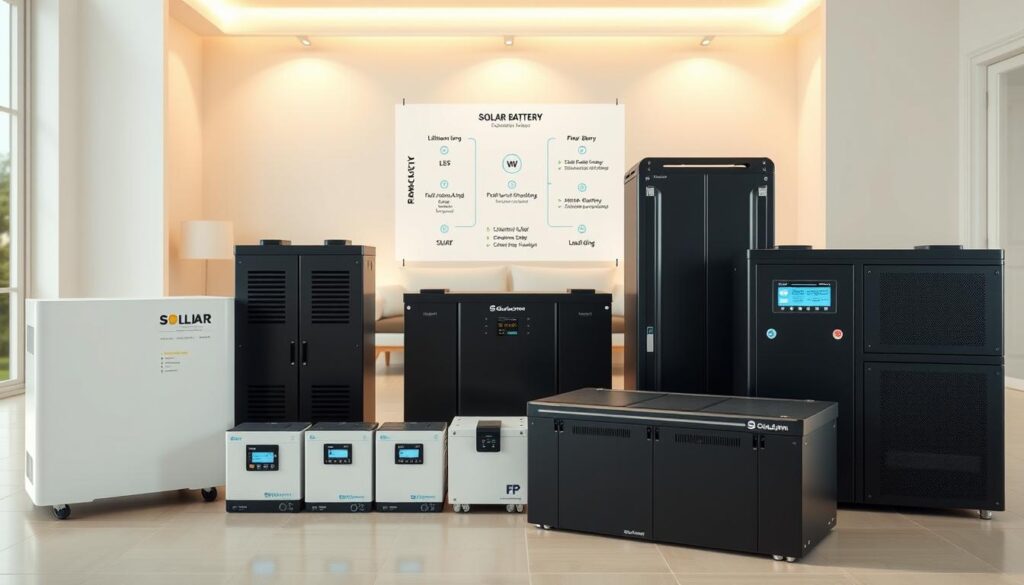Smart home solar batteries, like those from SolarEdge and Enphase, turn excess solar energy into savings. A home solar battery stores power generated during sunny days—like the optimal 10 AM–2 PM window—and uses it when peak rates hit 2–3x higher. With 30% efficiency gains through BESS optimization, homeowners slash bills by reducing reliance on costly grid electricity. Modern lithium systems now last 10–15 years, and federal tax credits cut upfront costs by 30%.
Residential solar storage systems now cost 11–25% less than 2016 models, per NREL. Apps from brands like Solar Insure let users track energy flow in real time, while warranties like their 20-year coverage ensure long-term reliability. The U.S. residential market is booming, growing from 180 MW in 2018 to 2,181 MW by 2023, Wood Mackenzie reports.
Key Takeaways
- Smart home solar battery systems cut electricity costs by up to 30% via peak shaving.
- Lithium batteries last 10–15 years with proper maintenance, extending longevity through regular monitoring.
- A 30% federal tax credit lowers upfront costs for eligible installations.
- Hybrid inverters from brands like Sol-Ark offer backup power during outages.
- Real-time apps and 20-year warranties maximize savings and reliability.
Understanding Home Solar Battery Technology
Home solar batteries are the backbone of modern energy independence. A solar energy storage system captures sunlight converted by panels, stores it, and delivers power when needed—day or night. Let’s break down how these systems work and what makes them tick.
How Home Solar Batteries Work
Imagine your home solar battery as a rechargeable powerhouse. Here’s the process:
- Solar panels convert sunlight into DC electricity.
- Excess energy flows to the battery for storage.
- An inverter converts stored DC power to AC for home use.
- Energy is released automatically when sunlight fades or the grid goes down.
Key Components of Solar Energy Storage Systems
Every system relies on these parts:
- Battery pack: Holds energy in lithium-ion cells (like Tesla Powerwall or LG Chem RESU).
- Inverter: Transforms power so it matches home appliances.
- Battery Management System (BMS): Monitors charge levels and safety.
- Grid tie system: Connects storage to the utility grid for buy/sell energy options.
Different Types of Battery Chemistry
Lithium-ion dominates the market due to longevity and efficiency. Let’s compare options:
Lithium-ion: Lasts over 10 years with high cycle counts. Ideal for most homes.
Lead-acid: Cheaper upfront but degrades faster, needing frequent replacement.
Saltwater: A niche option blending cost and eco-friendliness, though less common.
Choosing the right chemistry starts with your budget, energy goals, and how long you want the system to last. Lithium-ion’s popularity isn’t just hype—it’s built on proven reliability for daily use and emergency backup.
The Growing Importance of Residential Solar Storage
Climate change isn’t just a distant threat—it’s disrupting power grids today. Extreme weather events like hurricanes and wildfires cause outages that leave homes vulnerable. Residential solar storage offers a solution. By storing energy locally, homeowners gain resilience against grid failures and rising utility costs.

“The global residential solar energy storage market is projected to exceed $205 billion by 2032,” driven by demand for reliable energy independence.
Costs have dropped dramatically. A typical solar-plus-storage system now ranges from $12,000 to $35,000, but incentives like the Federal Investment Tax Credit (ITC) cut these expenses. Many states add rebates, making home battery storage affordable. Here’s why it matters:
- Protect against rate hikes: Time-of-use billing penalizes evening energy use. Home battery storage lets you use stored daytime solar power instead.
- Cut reliance on utilities: Over 90% of U.S. power still comes from fossil fuels. Home systems reduce that dependency.
- Backup power during disasters: When storms hit, solar storage keeps lights, fridges, and medical devices running.
Technologies like lithium-ion batteries have become cheaper and safer. Companies like Tesla, LG, and Sonnen now offer systems that last 10+ years. Smart home integration lets users track energy use in real time, optimizing savings.
Residential solar storage isn’t just for early adopters anymore. With prices falling 89% since 2010, it’s becoming a practical choice for everyday homeowners seeking reliability and savings.
Top Benefits of Installing a Home Solar Battery
Switching to a home solar battery brings more than just eco-friendly energy. These systems unlock practical advantages that save money, boost safety, and future-proof your home. Let’s explore why thousands of U.S. homeowners are making the switch.
Energy Independence and Reduced Utility Bills
A battery storage for home system slashes monthly bills by up to 40% by storing daytime solar energy. During peak hours—like evenings—your system uses stored power instead of expensive grid electricity. Federal incentives, including a 30% tax credit, also cut upfront costs. For example, a $15,000 system could cost as little as $10,500 after credits.
Backup Power During Outages
Unlike noisy generators, a home solar battery operates quietly, providing power during outages. Most setups power essentials like refrigerators and lights for 24–48 hours. The Enphase Encharge, for instance, offers 10-year warranties, outlasting traditional backup systems.
Environmental Impact and Carbon Footprint Reduction
“Solar batteries reduce emissions by minimizing grid reliance.”
By storing clean solar energy, these systems cut fossil fuel use. Homeowners in California especially benefit under new NEM 3.0 rules, which reward solar-plus-storage users with better billing rates. No fuel is needed—making them greener than gas generators.
Increased Property Value
- Studies show homes with solar batteries sell 20% faster than those without.
- Real estate platforms like Zillow report buyers prioritize homes with pre-installed home solar battery systems.
Investments in energy efficiency often recover 100% at resale, making them a smart long-term choice.
Choosing the Best Solar Battery System for Your Home
Choosing the right best solar battery system for your home battery storage setup requires careful evaluation. Start by matching the system to your energy needs and existing infrastructure. Here’s how to make an informed decision:

Capacity and Power Output Considerations
Capacity determines how much energy a battery can store. For example, the Bluetti EP900 offers 9 kW output and 13.5 kWh capacity, ideal for powering essentials during outages. The Tesla Powerwall 3 boosts power output to 11.5 kW, handling heavier loads. Calculate your daily kWh usage from utility bills to pick the right size. Most homes use 10–20 kWh, but off-grid setups may need larger options.
Compatibility with Existing Solar Installations
Ensure your home battery storage works with current solar panels. AC-coupled systems like the Generac PWRcell (9–36 kWh) pair easily with existing setups. DC-coupled systems, such as the Enphase IQ 5P, integrate seamlessly with microinverter systems. Check voltage compatibility and inverter requirements to avoid costly upgrades.
Warranty and Lifespan Factors
Look for warranties covering 10,000+ cycles. The Enphase IQ 5P offers a 15-year warranty, while FranklinWH guarantees 12 years. Most lithium batteries last 10–15 years, retaining 70% capacity by the end of their lifespan. Compare cycle counts and depth of discharge (DoD) ratings to maximize longevity.
| Brand | Capacity (kWh) | Warranty | Power Output (kW) |
|---|---|---|---|
| Bluetti EP900 | 13.5 | 10 years | 9 |
| Tesla Powerwall 3 | 13.5 | 10 years | 11.5 |
| Enphase IQ 5P | 5 | 15 years | 3.3 |
Pairing a best solar battery system with federal tax credits (30% off) and state incentives can lower costs. Work with certified installers to align your choice with energy goals and budget constraints.
Cost Analysis: Investment vs. Long-Term Savings
Investing in a home solar battery involves upfront costs, but the long-term savings make it a smart choice. A typical residential solar storage system costs between $7,000 and $15,000, covering the battery, inverters, and installation. Over time, this investment reduces or eliminates electricity bills while protecting against rising utility rates.
| Cost Component | Estimated Range |
|---|---|
| Battery Unit | $8,000–$15,000 (10–15 kWh) |
| Installation & Permits | 20–30% of total cost |
| Annual Savings | $500–$1,500+ (varies by usage) |
- Payback period: 5–7 years
- Monthly bill reductions: Up to 90% with solar panels paired with the battery
- ROI: 10–20% over 25+ years
Factors like local energy rates and system size affect returns. For example, a 5-kW system might cost $15,000–$25,000 fully installed. With tax credits like the federal 26% ITC, costs drop instantly. Homeowners in high-rate areas like California or New York see faster payback due to higher utility savings.
“A home solar battery isn’t just a purchase—it’s a decades-long savings engine.”
Financing options like loans or leases spread costs over time. Even with upfront spending, long-term savings outweigh initial expenses. Over 25 years, a system could save $20,000–$30,000 compared to grid-only usage. Prioritize quality components to maximize this return.
Off-Grid Solar Battery Solutions: Living Free from the Utility Grid
Breaking free from the grid means relying fully on your own solar energy storage system. An off-grid setup requires careful planning to ensure consistent power, even during cloudy days or high demand. Modern systems like the Pytes V5° battery, with its 491.52 kWh capacity when scaled, offer the reliability needed for full independence.
“Energy flows like water in a well-organized reservoir. When your solar panels generate power, your off-grid solar battery stores it for use when the sun isn’t shining.”

Complete Off-Grid System Requirements
A complete setup includes:
- Solar panels matched to your energy needs
- Batteries like the Pytes V5° (UL 9540 certified) for energy storage
- Inverters to convert DC to AC power
- Charge controllers to protect batteries
Sizing Your Battery Bank
Calculate daily energy use and multiply by days of autonomy (e.g., 5 days). Add 20% for efficiency losses. Example: A 30 kWh daily use requires a 150 kWh battery bank plus buffer.
Hybrid Systems: The Best of Both Worlds
Hybrid systems blend grid and off-grid advantages. They allow charging from the grid during low solar production but keep you powered during outages. The Pytes V5°’s scalability makes it ideal for hybrid setups, offering grid backup without full off-grid commitment.
Battery Storage for Home: Installation Process and Requirements
Installing a battery storage for home system starts with a site assessment. Professionals evaluate your electrical setup, energy habits, and space to design a system tailored to your needs. Most solar energy storage system setups require 4–6 square feet of space in a cool, dry area like a garage or basement. Ideal temperatures range between 32°F and 86°F to maintain efficiency and safety.
- Clean, ventilated installation zones away from moisture
- Compatibility with existing solar panels and inverters
- Permits from local authorities (costs vary by location)
- Electrical upgrades if your home’s wiring can’t handle the system
Installation steps follow a clear timeline: assessment → design → permit approval → hardware setup → testing → activation. Certified technicians handle wiring, ensuring alignment with NEC and local codes. Most projects take 1–3 days, with minimal disruption to daily routines.
Over 50% of homeowners install batteries for backup power, according to SolarReviews surveys.
Safety is non-negotiable: grounding, fire barriers, and circuit protection are mandatory. Always hire licensed electricians familiar withsolar energy storage systemstandards.
Costs range from $5,000 to $15,000, but federal tax credits (up to 30%) and state incentives reduce upfront expenses. Systems like the Tesla Powerwall (13.5 kWh) or Generac PWRcell (9–18 kWh) come with warranties ensuring 10+ years of performance.
Proper installation maximizes efficiency and longevity. Partner with certified installers to ensure your battery storage for home works safely and effectively for years.
Solar Panel Battery Backup: Emergency Power When You Need It Most
When the grid goes dark, a solar panel battery backup ensures your home stays powered. These systems activate instantly when outages occur, keeping essentials running without the noise or emissions of gas generators. Modern home solar battery setups detect grid loss in seconds and switch to stored energy seamlessly.
How Backup Systems Activate During Outages
During outages, grid-tied inverters automatically disconnect for safety. But solar panel battery backup systems bypass this limitation. Here’s how it works:
- Sensors detect grid failure within seconds
- Battery inverter takes over to power connected circuits
- Stored solar energy flows to preselected appliances
Systems like Tesla Powerwall or LG Chem RESU maintain power for critical loads without needing sunlight, relying on stored daytime energy.
Essential vs. Whole-Home Backup Options
Choose between two approaches:
- Essential Backup: Powers refrigerators, medical devices, and lighting. Costs less and uses smaller batteries.
- Whole-Home Backup: Requires larger systems to run HVAC, stoves, and other high-demand appliances. Best for frequent or long outages.
“During the ice storm, our home solar battery kept the fridge and medical equipment running for three days. No more generator fumes!” – Sarah M., Texas homeowner
Most households start with essential backups, expanding later if needed. Pairing with solar panels ensures daily recharging, extending outage resilience. Planning your critical load needs is key to sizing the right battery capacity for your family’s safety.
Maintenance and Longevity: Maximizing Your Battery’s Lifespan
Proper upkeep ensures your home battery storage system serves reliably for years. Modern lithium-ion systems, like those from Tesla Powerwall or Sonnen, last 10–15 years when maintained correctly. Here’s how to keep your investment running smoothly:
Routine Maintenance Tips
- Keep installation areas clean and well-ventilated to avoid overheating
- Check connections every 6 months for corrosion or wear
- Aim to keep battery temperature between 50–85°F (10–29°C)
- Follow manufacturer guidelines for depth-of-discharge (DoD): 50% max for lead-acid, up to 80% for lithium
Monitoring System Performance
“Lithium systems with advanced BMS (Battery Management Systems) reduce manual checks by 60% compared to older models,” says LG Chem Energy Solutions. Track these metrics monthly:
- State of Charge (SoC) levels
- Cycle count vs. manufacturer specifications
- Charge time consistency
When to Replace or Upgrade
Signs Replacement is Needed Action Required Capacity drops below 80% of original Contact installer for diagnostics Charge times double from initial performance Evaluate replacement options Visible physical damage or error codes Arrange professional inspection Modern battery storage for home systems like Tesla Powerwall 3 or Enphase IQ 10 require less hands-on care than older lead-acid models. But annual professional inspections and firmware updates are still vital. Always recycle end-of-life batteries through certified programs like Call2Recycle to stay compliant with EPA guidelines.
Federal and State Incentives for Home Battery Storage
Home battery storage can become more affordable through federal and state programs designed to encourage renewable energy adoption. The federal Investment Tax Credit (ITC) currently covers 30% of eligible costs for systems installed by 2032, reducing to 26% in 2023 and 22% in 2024. These credits apply to systems paired with solar panels, lowering upfront costs significantly.
- Federal Benefits: The 30% tax credit applies to batteries with at least 3 kWh capacity. For example, a Tesla Powerwall (13.5 kWh) might qualify for $4,950 in savings under the 2023 ITC rate.
- State Programs: California’s SGIP offers rebates up to $1,000 per kWh, while Connecticut provides up to $16,000 for residential solar storage. Massachusetts’ Mass Save program offers zero-interest loans, and New York’s Long Island initiative gives $250 per kW.
- Utility Rebates: Green Mountain Power in Vermont offers rebates up to $10,500 for systems that share energy with the grid during peak hours.
Combining incentives can slash costs further. Oregon’s Solar + Storage program offers $300 per kWh, capping at $2,500. Minnesota’s rebates reach $7,000 for non-Xcel customers. These programs often require systems to meet efficiency standards, like Energy Star certification for heat pumps or SRCC certification for solar water heaters.
“Tax credits and rebates make residential solar storage accessible to more households,” says the IRS. “Qualifying systems must be new and meet minimum capacity requirements.”
Homeowners should check local programs before installation. Many states, like Maryland, are launching new incentives in 2025. Working with certified installers ensures eligibility for stacked rebates and tax credits. With these savings, a 6.5kW solar-battery system could generate over $10,800 in incentives over ten years through programs like Massachusetts’ SMART.
Conclusion: Powering Your Future with Home Solar Battery Technology
Home solar batteries like Afore’s LiFePO4 systems offer up to 5120Wh capacity, providing reliable solar panel battery backup during outages. With 6000 cycles and a 5-year lifespan, these systems deliver long-term savings compared to older technologies like lead-acid. Their IP65 rating ensures durability, making them top contenders for the best solar battery system.
Future innovations like FranklinWH’s AC-coupled systems, expandable up to 204 kWh, highlight scalability. Solid-state tech promises faster charging and safety, while falling costs make solar storage accessible. These advancements align with trends toward sustainable energy independence.
Ready to take control? Start by assessing your energy needs and researching local incentives. Partner with certified installers to pair solar panels with reliable battery systems. With improved efficiency and lower costs, now is the time to invest in a resilient energy future. Afore’s 50.5kg low-voltage models and FranklinWH’s 13.6 kWh base system offer tailored solutions. Don’t wait—embrace energy independence today.
